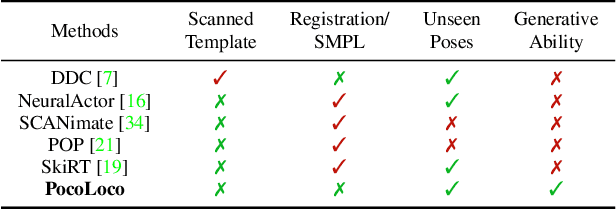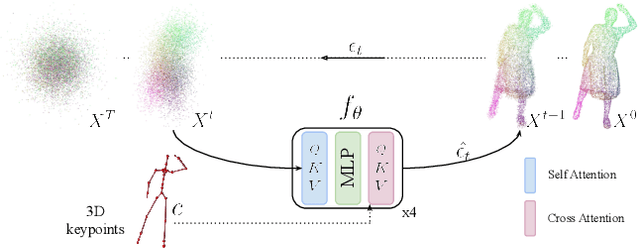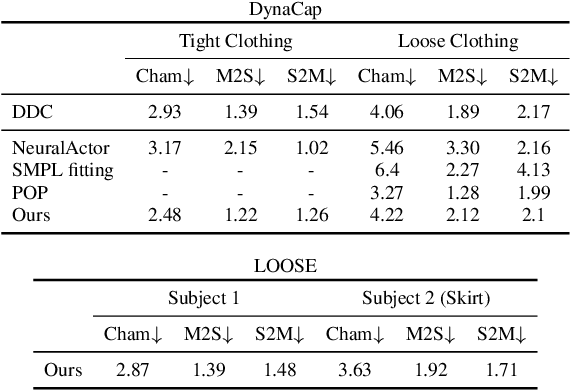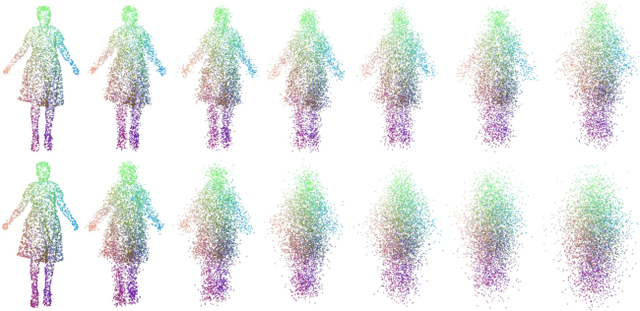Adam Kortylewski
Max Planck Institute for Informatics, University of Freiburg
CNS-Bench: Benchmarking Image Classifier Robustness Under Continuous Nuisance Shifts
Jul 23, 2025Abstract:An important challenge when using computer vision models in the real world is to evaluate their performance in potential out-of-distribution (OOD) scenarios. While simple synthetic corruptions are commonly applied to test OOD robustness, they often fail to capture nuisance shifts that occur in the real world. Recently, diffusion models have been applied to generate realistic images for benchmarking, but they are restricted to binary nuisance shifts. In this work, we introduce CNS-Bench, a Continuous Nuisance Shift Benchmark to quantify OOD robustness of image classifiers for continuous and realistic generative nuisance shifts. CNS-Bench allows generating a wide range of individual nuisance shifts in continuous severities by applying LoRA adapters to diffusion models. To address failure cases, we propose a filtering mechanism that outperforms previous methods, thereby enabling reliable benchmarking with generative models. With the proposed benchmark, we perform a large-scale study to evaluate the robustness of more than 40 classifiers under various nuisance shifts. Through carefully designed comparisons and analyses, we find that model rankings can change for varying shifts and shift scales, which cannot be captured when applying common binary shifts. Additionally, we show that evaluating the model performance on a continuous scale allows the identification of model failure points, providing a more nuanced understanding of model robustness. Project page including code and data: https://genintel.github.io/CNS.
Do It Yourself: Learning Semantic Correspondence from Pseudo-Labels
Jun 05, 2025Abstract:Finding correspondences between semantically similar points across images and object instances is one of the everlasting challenges in computer vision. While large pre-trained vision models have recently been demonstrated as effective priors for semantic matching, they still suffer from ambiguities for symmetric objects or repeated object parts. We propose to improve semantic correspondence estimation via 3D-aware pseudo-labeling. Specifically, we train an adapter to refine off-the-shelf features using pseudo-labels obtained via 3D-aware chaining, filtering wrong labels through relaxed cyclic consistency, and 3D spherical prototype mapping constraints. While reducing the need for dataset specific annotations compared to prior work, we set a new state-of-the-art on SPair-71k by over 4% absolute gain and by over 7% against methods with similar supervision requirements. The generality of our proposed approach simplifies extension of training to other data sources, which we demonstrate in our experiments.
Common3D: Self-Supervised Learning of 3D Morphable Models for Common Objects in Neural Feature Space
Apr 30, 2025Abstract:3D morphable models (3DMMs) are a powerful tool to represent the possible shapes and appearances of an object category. Given a single test image, 3DMMs can be used to solve various tasks, such as predicting the 3D shape, pose, semantic correspondence, and instance segmentation of an object. Unfortunately, 3DMMs are only available for very few object categories that are of particular interest, like faces or human bodies, as they require a demanding 3D data acquisition and category-specific training process. In contrast, we introduce a new method, Common3D, that learns 3DMMs of common objects in a fully self-supervised manner from a collection of object-centric videos. For this purpose, our model represents objects as a learned 3D template mesh and a deformation field that is parameterized as an image-conditioned neural network. Different from prior works, Common3D represents the object appearance with neural features instead of RGB colors, which enables the learning of more generalizable representations through an abstraction from pixel intensities. Importantly, we train the appearance features using a contrastive objective by exploiting the correspondences defined through the deformable template mesh. This leads to higher quality correspondence features compared to related works and a significantly improved model performance at estimating 3D object pose and semantic correspondence. Common3D is the first completely self-supervised method that can solve various vision tasks in a zero-shot manner.
Escaping Plato's Cave: Robust Conceptual Reasoning through Interpretable 3D Neural Object Volumes
Mar 17, 2025Abstract:With the rise of neural networks, especially in high-stakes applications, these networks need two properties (i) robustness and (ii) interpretability to ensure their safety. Recent advances in classifiers with 3D volumetric object representations have demonstrated a greatly enhanced robustness in out-of-distribution data. However, these 3D-aware classifiers have not been studied from the perspective of interpretability. We introduce CAVE - Concept Aware Volumes for Explanations - a new direction that unifies interpretability and robustness in image classification. We design an inherently-interpretable and robust classifier by extending existing 3D-aware classifiers with concepts extracted from their volumetric representations for classification. In an array of quantitative metrics for interpretability, we compare against different concept-based approaches across the explainable AI literature and show that CAVE discovers well-grounded concepts that are used consistently across images, while achieving superior robustness.
PocoLoco: A Point Cloud Diffusion Model of Human Shape in Loose Clothing
Nov 06, 2024



Abstract:Modeling a human avatar that can plausibly deform to articulations is an active area of research. We present PocoLoco -- the first template-free, point-based, pose-conditioned generative model for 3D humans in loose clothing. We motivate our work by noting that most methods require a parametric model of the human body to ground pose-dependent deformations. Consequently, they are restricted to modeling clothing that is topologically similar to the naked body and do not extend well to loose clothing. The few methods that attempt to model loose clothing typically require either canonicalization or a UV-parameterization and need to address the challenging problem of explicitly estimating correspondences for the deforming clothes. In this work, we formulate avatar clothing deformation as a conditional point-cloud generation task within the denoising diffusion framework. Crucially, our framework operates directly on unordered point clouds, eliminating the need for a parametric model or a clothing template. This also enables a variety of practical applications, such as point-cloud completion and pose-based editing -- important features for virtual human animation. As current datasets for human avatars in loose clothing are far too small for training diffusion models, we release a dataset of two subjects performing various poses in loose clothing with a total of 75K point clouds. By contributing towards tackling the challenging task of effectively modeling loose clothing and expanding the available data for training these models, we aim to set the stage for further innovation in digital humans. The source code is available at https://github.com/sidsunny/pocoloco .
TEDRA: Text-based Editing of Dynamic and Photoreal Actors
Aug 28, 2024



Abstract:Over the past years, significant progress has been made in creating photorealistic and drivable 3D avatars solely from videos of real humans. However, a core remaining challenge is the fine-grained and user-friendly editing of clothing styles by means of textual descriptions. To this end, we present TEDRA, the first method allowing text-based edits of an avatar, which maintains the avatar's high fidelity, space-time coherency, as well as dynamics, and enables skeletal pose and view control. We begin by training a model to create a controllable and high-fidelity digital replica of the real actor. Next, we personalize a pretrained generative diffusion model by fine-tuning it on various frames of the real character captured from different camera angles, ensuring the digital representation faithfully captures the dynamics and movements of the real person. This two-stage process lays the foundation for our approach to dynamic human avatar editing. Utilizing this personalized diffusion model, we modify the dynamic avatar based on a provided text prompt using our Personalized Normal Aligned Score Distillation Sampling (PNA-SDS) within a model-based guidance framework. Additionally, we propose a time step annealing strategy to ensure high-quality edits. Our results demonstrate a clear improvement over prior work in functionality and visual quality.
iNeMo: Incremental Neural Mesh Models for Robust Class-Incremental Learning
Jul 12, 2024Abstract:Different from human nature, it is still common practice today for vision tasks to train deep learning models only initially and on fixed datasets. A variety of approaches have recently addressed handling continual data streams. However, extending these methods to manage out-of-distribution (OOD) scenarios has not effectively been investigated. On the other hand, it has recently been shown that non-continual neural mesh models exhibit strong performance in generalizing to such OOD scenarios. To leverage this decisive property in a continual learning setting, we propose incremental neural mesh models that can be extended with new meshes over time. In addition, we present a latent space initialization strategy that enables us to allocate feature space for future unseen classes in advance and a positional regularization term that forces the features of the different classes to consistently stay in respective latent space regions. We demonstrate the effectiveness of our method through extensive experiments on the Pascal3D and ObjectNet3D datasets and show that our approach outperforms the baselines for classification by $2-6\%$ in the in-domain and by $6-50\%$ in the OOD setting. Our work also presents the first incremental learning approach for pose estimation. Our code and model can be found at https://github.com/Fischer-Tom/iNeMo.
Unsupervised Learning of Category-Level 3D Pose from Object-Centric Videos
Jul 05, 2024



Abstract:Category-level 3D pose estimation is a fundamentally important problem in computer vision and robotics, e.g. for embodied agents or to train 3D generative models. However, so far methods that estimate the category-level object pose require either large amounts of human annotations, CAD models or input from RGB-D sensors. In contrast, we tackle the problem of learning to estimate the category-level 3D pose only from casually taken object-centric videos without human supervision. We propose a two-step pipeline: First, we introduce a multi-view alignment procedure that determines canonical camera poses across videos with a novel and robust cyclic distance formulation for geometric and appearance matching using reconstructed coarse meshes and DINOv2 features. In a second step, the canonical poses and reconstructed meshes enable us to train a model for 3D pose estimation from a single image. In particular, our model learns to estimate dense correspondences between images and a prototypical 3D template by predicting, for each pixel in a 2D image, a feature vector of the corresponding vertex in the template mesh. We demonstrate that our method outperforms all baselines at the unsupervised alignment of object-centric videos by a large margin and provides faithful and robust predictions in-the-wild. Our code and data is available at https://github.com/GenIntel/uns-obj-pose3d.
ImageNet3D: Towards General-Purpose Object-Level 3D Understanding
Jun 13, 2024



Abstract:A vision model with general-purpose object-level 3D understanding should be capable of inferring both 2D (e.g., class name and bounding box) and 3D information (e.g., 3D location and 3D viewpoint) for arbitrary rigid objects in natural images. This is a challenging task, as it involves inferring 3D information from 2D signals and most importantly, generalizing to rigid objects from unseen categories. However, existing datasets with object-level 3D annotations are often limited by the number of categories or the quality of annotations. Models developed on these datasets become specialists for certain categories or domains, and fail to generalize. In this work, we present ImageNet3D, a large dataset for general-purpose object-level 3D understanding. ImageNet3D augments 200 categories from the ImageNet dataset with 2D bounding box, 3D pose, 3D location annotations, and image captions interleaved with 3D information. With the new annotations available in ImageNet3D, we could (i) analyze the object-level 3D awareness of visual foundation models, and (ii) study and develop general-purpose models that infer both 2D and 3D information for arbitrary rigid objects in natural images, and (iii) integrate unified 3D models with large language models for 3D-related reasoning.. We consider two new tasks, probing of object-level 3D awareness and open vocabulary pose estimation, besides standard classification and pose estimation. Experimental results on ImageNet3D demonstrate the potential of our dataset in building vision models with stronger general-purpose object-level 3D understanding.
FaceGPT: Self-supervised Learning to Chat about 3D Human Faces
Jun 11, 2024



Abstract:We introduce FaceGPT, a self-supervised learning framework for Large Vision-Language Models (VLMs) to reason about 3D human faces from images and text. Typical 3D face reconstruction methods are specialized algorithms that lack semantic reasoning capabilities. FaceGPT overcomes this limitation by embedding the parameters of a 3D morphable face model (3DMM) into the token space of a VLM, enabling the generation of 3D faces from both textual and visual inputs. FaceGPT is trained in a self-supervised manner as a model-based autoencoder from in-the-wild images. In particular, the hidden state of LLM is projected into 3DMM parameters and subsequently rendered as 2D face image to guide the self-supervised learning process via image-based reconstruction. Without relying on expensive 3D annotations of human faces, FaceGPT obtains a detailed understanding about 3D human faces, while preserving the capacity to understand general user instructions. Our experiments demonstrate that FaceGPT not only achieves high-quality 3D face reconstructions but also retains the ability for general-purpose visual instruction following. Furthermore, FaceGPT learns fully self-supervised to generate 3D faces based on complex textual inputs, which opens a new direction in human face analysis.
 Add to Chrome
Add to Chrome Add to Firefox
Add to Firefox Add to Edge
Add to Edge